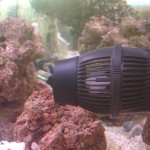Like I mentioned before, my original plan was to restart the aquarium as just marine fish. So what happened?
For those that aren’t familiar with the terminology, a reef aquarium is primarily focused on corals, anemones, sponges and other types of marine invertebrates. They don’t move, at least not on their own, but they are living organisms. Most marine invertebrates used in reef aquariums are very colorful, and make for a very pleasing visual experience. Reef aquariums sometimes will contain a few carefully picked live fish as well.
On the other hand, a marine, or salt water aquarium, will often have live rock, but no marine invertebrates. Instead, it will focus on live fish, and sometimes will have some empty sea shells. A marine aquarium doesn’t have to be as picky with fish because you don’t really care if they eat coral or not. You just need to make sure that the fish themselves will get along with each other.
Mrs Salty Geek, one of my sons and I decided that it was time to add a fish. By this time the aquarium had sat for 4 months with just live rock. So, we decided to go to San Jose to look for fish. After about four not-so-good fish stores we finally found a good one that we’d never been to before. As one of the employees came over to help us, he asked a question that no one had asked before: “Do you want reef safe fish?” I started into my usual routine, describing how difficult reefs were, but the employee started correcting my misconceptions.
Just like there are fish that are easy to keep healthy, and others that are more challenging, the same is true of marine invertebrates. Most soft corals are fairly hardy. Large polyp stony (LPS) corals are a little more challenging. Small polyp stony (SPS) corals, on the other hand, can be quite challenging.
When I described all of the filtration equipment I already have to the store employee, he seemed satisfied. I think the protein skimmer was a key. With the filtration equipment and live rock that we already have, he was confident that we would be able to keep the chemical balance of the aquarium in good shape.
There are still things that need to be fixed, however. The most important part is lighting. Corals require lots of light to survive and grow. Even though they don’t look like plants, and technically are not plants, they still do use photosynthesis to survive. In my marine aquarium, lighting was not important, so I just used a standard 40 watt florescent light in the hood that came with the aquarium. I’m planing on correcting this problem, but I’ll get into details in another post.
The other thing I didn’t have was sufficient water circulation. Since corals and anemones don’t move, they have to wait for nutrients to come to them. Likewise, any waste they produce will just sit on them if there is no current. In the ocean this happens in the form of waves and tides. In a reef aquarium, water circulation is often created by a submersible pump. Recently Mrs Salty surprised me with a Koralia 3 pump for our future reef aquarium. The fish seem to like it too – they swim in and out of its stream. The only problem is I have to shut the pump off when I feed the fish, because the brine shrimp go shooting all over the tank if I don’t.
After this discussion at the fish store, I couldn’t keep the thought out of my head… “I really could build a reef tank!” It just seemed like too much fun to pass up. Since that time, I’ve been doing hours of Internet research, and skulking through many area salt water aquarium stores.

I knew you took great pride in geekishness – – which I can appreciate! But wow – this is a very cool website 🙂